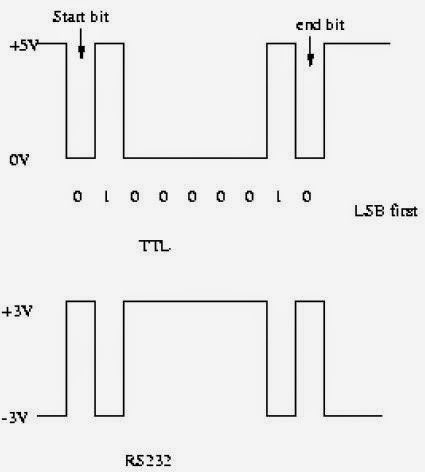RS232C
 |
| Fig 1: Serial waveforms |
- Standard-RS-232 is the Short for recommended standard-232C, a standard interface approved by the Electronic Industries Alliance (EIA) for connecting serial devices.
- The EIA released a new version of the standard and changed the name to EIA-232-D.
- The example serial waveforms in Fig 1 show the waveform on a single conductor to transmit a byte serially.
- The upper waveform is the TTL-level waveform seen(transistor-transistor logic) at the transmit pin of 8051.
- The voltage level of the RS232C are used to assure error-free transmission over greater distances than would be possible with TTL levels.
- The start and stop bits are used to synchronize the serial recivers.
- The bits are transmitted at specific time intervals determined by the baud rate of the serial signal.
- RS-232 is a standard by which two serial devices communicate:
- Transmission voltages are –15V and +15V.
- Almost all modems conform to the EIA-232 standard and most personal computers have an EIA-232 port for connecting a modem or other device.
- In addition to modems, many display screens, mice, and serial printers are designed to connect to a EIA-232 port.
- The device that connects to the interface is called a Data Communications Equipment (DCE) and the device to which it connects (e.g., the computer) is called a Data Terminal Equipment (DTE).
- The EIA-232 standard supports two types of connectors.
- 25-pin D-type connector.
- 9-pin D-type connector.
RS-232 INTERFACE
- The RS-232 interface is the Electronic Industries Association (EIA) standard for the interchange of serial binary data between two devices.
- It was initially developed by the EIA to standardize the connection of computers with telephone line modems.
- Three wires are sufficient: send data, receive data, and signal ground.
- The remaining lines can be hardwired on or off permanently.
- An asynchronous word consisting of: a start bit, seven or eight data bits, an optional parity bit and one or two stop bits.
- The standard RS-232-C connector has 25 pins.
- Many of the modem signals are not needed when a computer terminal is connected directly to a computer.
- An RS-232 serial port was once a standard feature of a personal computer, used for connections to modems, printers, mice, data storage, and other peripheral devices. However, the low transmission speed, large voltage swing, and large standard connectors motivated development of the Universal Serial Bus.
Limitations of the standard
- The large voltage swings and requirement for positive and negative supplies increases power consumption of the interface and complicates power supply design.
- Single-ended signaling referred to a common signal ground limits the noise immunity and transmission distance.
- No method is specified for sending power to a device.
- The 25-way connector recommended in the standard is large compared to current practice.

Comments
Post a Comment